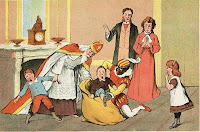Barry John: "The public may never know the terror that lurks in the shadowy depths."
If they're lucky, and if their guardians stay true to the grim task ahead.
It's the terrible truths that must be suppressed, after all, not the merely nasty myths.
One can endure and recover from being made to perceive and even believe a horrible lie. One can awaken or be awakened from such a nightmare. Truth can be a remedy to such a falsehood.
"Oh, that was just a movie, those were just actors with makeup, everyone's alive and making other films now, here are their latest projects, see?"
Yet other tales must never be told in the first place, because they cannot be taken back, retracted, recanted, disproved. Once seen, they cannot be unseen nor waved away by other evidence.
Their deepest horror is simply that they are not at all fictional; they have only thus far been not known... but once learned, they cannot be forgotten, to the learner's dismay and misery. There is no Lethe in this lifetime.
I could tell people why I shake, tremble, and am brought to tears — not of fear, my friends, but of rage, shame, and a desire to tear down the pillars of society, to scream at innocent parents to grab their children and run for safety, and to tear a friendly mask away that no-one has dared look behind for some two thousand years — but they would not want to hear me. What would it gain them? The same anguish I have, no more. Certainly no hope of social esteem. One would be thought mad if one spoke of it in public. So I do my best to tamp this knowledge down. I see, I know, it flickers at the back of my mind, I say nothing, I turn away. Thus I keep my own mask on, watching the older and darker mask being maintained.
The thing is, you seekers after darkness here probably know all the clues already, so there's nothing left to doubt. All it takes is putting the pieces together:
- Item: inevitably, children cry and scream and wet themselves in fear of a happy friendly figure at a happy time despite their parents' best reassurances; this is always explained as irrationality on the part of children.
(One reader insists: "But children are always afraid of strangers!" Well, no, not all children, not always, not of all strangers, and certainly not to this extreme degree. If they were, it would be remarkable. They are more afraid of this figure than of others — yet supposedly he is not a stranger, or at least children's parents are not introducing him as one.)
- Item: this happy time dates back to the week-long Roman gift-giving festival Saturnalia in late December, dedicated to the red-cloaked god Saturn: "The potential cruelty of Saturn was enhanced by his identification with Cronus, known for devouring his own children. He was thus equated with the Carthaginian god Ba'al Hammon, to whom children were supposedly sacrificed."
- Item: in Plato's Meno dialogue, Socrates demonstrates his theory of anamnesis (knowledge remembered from prior lives) by posing geometrical puzzles to an untaught slave boy who can solve them.
- Item: Carthaginian children were taken on festival days to meet their people's beloved god; they were told the gifts their god would give them in heaven; they were told wishes and prayers to relay to the god from their parents, priests, kings, all their people; then they were led up the aisle to their god's great altar and sacrificed... not quickly by a throat-cutting with one of those little daggers, oh no, but by burning in a brazier.
 (It is always worth remembering that the constant companion of the generous gift-giver to the "nice" children is the giver of coal pieces to the "naughty" children, and what message beyond a reminder of burning is conveyed by a gift of coal?)
(It is always worth remembering that the constant companion of the generous gift-giver to the "nice" children is the giver of coal pieces to the "naughty" children, and what message beyond a reminder of burning is conveyed by a gift of coal?) - Item: if Socrates was right, at some level, some kids today remember this; that's why they cry and scream and wet themselves when they reprise the experience at the line for Santa in the Christmas mall. They just can't explain.
Just like Cthulhu, as the old song says:
... Whether boiled or baked or fried,
With some french fries on the side,
[Cthulhu/Santa] loves the little children of the world!
[detail of Saturn Devouring His Son by Peter Paul Rubens, 1636]
ObMythos: For lack of space in the original Propnomicon comment, I omitted one little footnote about Santa/Saturn's Carthaginian counterpart Ba'al Hammon:
He was also identified with Dagon.
Not Lovecraft's Ponapean or Innsmouthean Dagon, perhaps, but the Middle-Eastern original that inspired him.
 |
| Bagging the naughty to take them away |
No little "fishy" or "lizard" pendants here, though; the cult's denoted by happy jolly kitschy red-cheeked white-bearded laughing fat old men's faces in white-fur-trimmed red conical caps, all molded in plastic, posted everywhere, over every retail store and your neighbors' front doors.
What? Not yours too? Why, you heretic, you heathen! Repent, convert, or die!
And as usual, humanity blindly refuses to ask obvious questions, e.g.:
- How do natural materials like polar-bear fur, that come in white, get dyed that signature red? With what?
- On what diet does this infamous morbid obesity persist?
- How does he continue to reside at the North Pole long after the ice-cap has melted to open ocean?
[That last, alone, should have alerted Dagon's foes.]
The Bloody-Robed Elder God [excerpt]: "Kringle!"
Henry Armitage's voice blew across the windswept rooftop of the Manhattan Macy's building on this late December midnight, down the red carpet incongruously placed from the stairway-top access door to the ornamented throne even more incongruously placed by the roof's edge.
The obscenely jolly and roly-poly red-clad figure seated there belched loudly, and casually brushed the terrified toddler from atop its crimson knees to let him huddle sobbing alone next to the throne. Beside and beneath its smiling rosy lips, its white beard constricted into cords, dreadlocks, and finally tentacles, pulling right and left like a curtain to reveal its true mouth below, vertical and fanged, gnashing the words: "Come forward; a larger meal would please me more."
Armitage hadn't waited for the invitation. Bearing the sign of the Unconquered Sun in his fist, he marched down the carpet, denouncing: "Dagon! Ba'al Hammon! Saturn! Devourer of Children! You have had your last meal in this place! You have no more allies here! Go!"
The thing on the throne tilted its head at the sound of an echoing boom from over the other edge of the roof, and its belly... no, it is better not to describe how its belly moved. But its voice could be said to have expressed some form of humor: "No more allies? But here come my allies now, even sooner than expected."
Quickly, all around them, came the pitter-patter of little hooves... and antlers... and skulls... and other body parts....
As the thing on the throne looked about in puzzlement and growing shock, another man (darkly clad in fedora and mackintosh, leaving only his nosetip illuminated by his cigarette) emerged from the rooftop shadows to exchange greetings with the thing's challenger:
"Hello, Armitage."
"Hello, Pearson.* Nitro?"
"Dynamite. Stabler."
"Took them all out pretty fast."
"They shouldn't have let me join in all their silly games."
_______________
(* Hommage á William Jones, The Strange Cases of Rudolph Pearson, Chaosium, 2008.)
_______________
_______________
Related topic: The Decorated Tree

According to the ancient Babylonians, Semiramis (who was believed to be both Nimrod's mother and wife – also known as Astarte, Asherah, Ashtoreth, Isis, Ishtar and Easter) made the claim that after Nimrod died, an evergreen tree sprang up overnight from a dead tree stump. Semiramis claimed that Nimrod visited the evergreen tree and left gifts each year on the anniversary of his birth (December 25th).*
Cf. Deuteronomy 16:21-22: “You shall not plant for yourself an Asherah of any kind of tree beside the altar of the LORD your God, which you shall make for yourself. You shall not set up for yourself a sacred pillar which the LORD your God hates.”
1 Kings 14:23: “For they also built for themselves high places and sacred pillars and Asherim on every high hill and beneath every luxuriant tree.”
Jeremiah 10:3-5: “For the customs of the peoples are vanity. A tree from the forest is cut down and worked with an axe by the hands of a craftsman. They decorate it with silver and gold; they fasten it with hammer and nails so that it cannot move. Their idols are like scarecrows in a cucumber field, and they cannot speak; they have to be carried, for they cannot walk. Do not be afraid of them, for they cannot do evil, neither is it in them to do good.”
1 John 5:21: “Little children, keep yourselves from idols. Amen.”
* quoted verbatim from http://glorifygod.com.au/articles/origins-christmas/
_______________
Thus judiciously consider the very authoritative words of Rev. Francis Xavier Weiser, S.J., in 1952's The [Catholic] Christmas Book: “The Christ [sic] tree is completely Christian in origin, and historians have never been able to connect it in any way with ancient Germanic or Asiatic mythology.” [emphasis added]
Alas, no Bible verses can be cited in support of this “completely Christian” custom. However, Father Weiser notes, “in the fifteenth century the custom developed of decorating the Paradise tree, already bearing apples,” like evergreen trees everywhere, “with small white wafers representing the Holy Eucharist” — which, being transubstantiated, is the very body of Christ and to be venerated as such, hence his use of the term “Christ tree”. But this effective veneration of the tree as divine (i.e. as Christ) is precisely what makes it idolatry.
Alas, no Bible verses can be cited in support of this “completely Christian” custom. However, Father Weiser notes, “in the fifteenth century the custom developed of decorating the Paradise tree, already bearing apples,” like evergreen trees everywhere, “with small white wafers representing the Holy Eucharist” — which, being transubstantiated, is the very body of Christ and to be venerated as such, hence his use of the term “Christ tree”. But this effective veneration of the tree as divine (i.e. as Christ) is precisely what makes it idolatry.


No comments:
Post a Comment